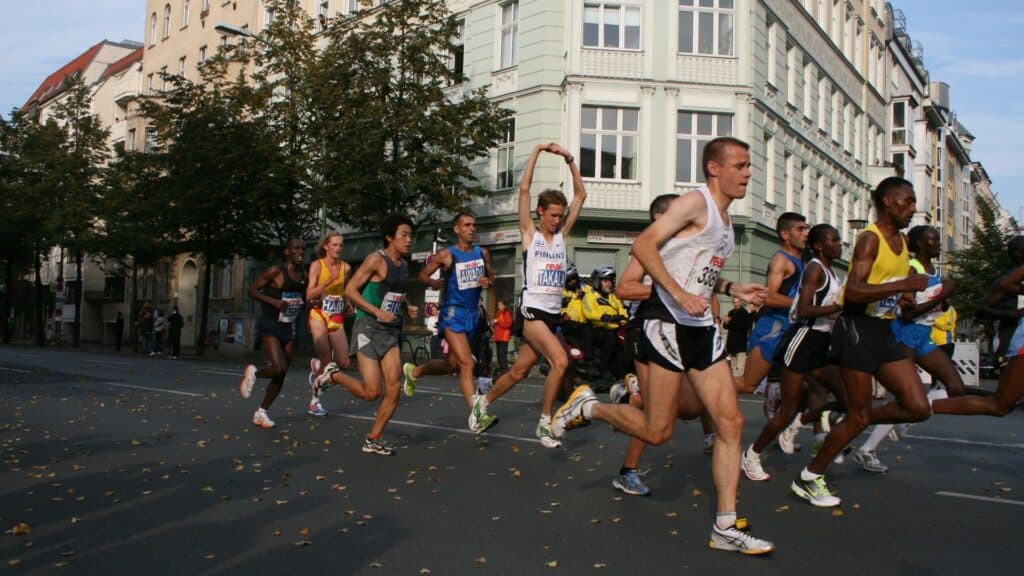The Berlin Marathon is renowned as one of the world’s most prestigious races, known for its fast course and attracting runners aiming to achieve personal bests or qualify for other races.
Meeting the qualifying times is a crucial requirement for participating in this highly anticipated event.
If you’re aiming to qualify for the Berlin Marathon, the required times vary based on age and gender. For men, the qualifying times range from around 2 hours and 45 minutes to 3 hours and 25 minutes, depending on their age group. As for women, the qualifying times range from approximately 3 hours to 4 hours and 10 minutes.
These time standards ensure that the race maintains its competitive nature and attracts top runners from around the world.
In this blog post, we will delve into the Berlin Marathon qualifying times and offer valuable tips and strategies to help you meet these requirements.
So, let’s get started…

How Do I Enter The Berlin Marathon?
To enter the Berlin Marathon, you have several options:
- AIMS-Certified Fast Runner
- Through Charity Partners:
- Through Tour Operators
- Lottery System
- AIMS-Certified Fast Runner
If you’re a fast runner and have achieved a qualifying time, you can register as an AIMS-certified runner. This means you meet the required standards set by the Association of International Marathons and Distance Races.
To register, you need to create a user account on the SCC Events website. Then, you can digitally add proof of your best marathon time to your registration form. The proof must not be older than 3 years.
If your time meets the qualifying criteria, you will receive a confirmation in December (the previous year). If not, your registration will be entered into the lottery.
The registration fee is approximately €163.
What Are The Qualifying Times?
The qualifying times for men and women may vary based on age groups.
| Age | 18-44 years old | 44-59 years old | 60+ years old |
| Man | 2:45 hours | 2:55 hours | 3:25 hours |
| Women | 3:00 hours | 3:20 hours. | 4:10 hours |
- Charity Partners
Another way to secure a spot in the Berlin Marathon is by registering with a charity partner.
Many charities have allocated entries for the marathon, and you can participate by committing to raising a certain amount of money for the organization.
This option allows you to contribute to a worthy cause while participating in the race.
Here are some of the charity partners found in Europe:
- Realbuzz Group Ltd
- GET KIDS GOING!
- Achilles International Germany
- Björn Schulz Stiftung
- i-MED Vision
- Stiftung KinderHerz
- Imagine for Margo – Children without Cancer
For a full list, please visit the official BMW Berlin Marathon website.
- Tour Operators
Tour operators and travel agencies often offer marathon packages that include guaranteed entry to the Berlin Marathon.
These packages typically include travel arrangements, accommodations, and additional perks. It can be a convenient and hassle-free way to participate in the race, especially for international runners.
One significant advantage is that tour operators often have access to race entries even after the general lottery drawing has taken place.
This means that participants who may not have secured a spot through the lottery can still have the opportunity to participate in the marathon.
Here are some of the tour operators found in Europe:
- 2:09 Events Ltd
- Marathon Tours & Travel
- Running Crazy Ltd.
- Sports Tours International
- Swinley Travel Ltd
- Runners unlimited by Ruefa
To find a comprehensive list of tour operators for the BMW Berlin Marathon, simply visit the official BMW Berlin Marathon website.
There, you will have access to the full roster of tour operators who offer packages and services for participants. This will help you explore your options and choose the tour operator that best suits your needs and preferences.
- Lottery System
The Berlin Marathon offers an entry option through a lottery system, giving interested participants a chance to secure a spot in the race.
To enter the lottery, you can apply online during the designated registration period. Please note that entering the lottery does not guarantee a spot, as the selection is determined through a random drawing.
When applying for the lottery, you have the choice to register as an individual or as part of a team of 2-3 people. If a team is selected, all members of the team will receive a marathon entry, but there is no team ranking in the race.
The deadline to submit your lottery application is typically from 29 September until 23:59 (UTC +1:00) on 17 November of the preceding year.
It’s important to note that there is no fee to enter the lottery, and only those selected as winners will be required to pay the marathon entry fee of €163
Each person is allowed to submit only one application, either as an individual or as part of a team. Notifications regarding the entry status will be sent to lottery applicants via email on December 1 of the preceding year.
So now that you’re aware of the various options to enter the prestigious BMW Berlin Marathon, let’s delve into the eligibility criteria and who is allowed to participate in this exciting event.
Who Is Allowed To Participate?
The BMW Berlin Marathon is open to participants who meet certain criteria:
- Age Requirement: Participants must be 18 years old or older (born in 2005 or earlier) to be eligible to attend the race.
- Time Limit: All participants must complete the course within a time limit of 6 hours and 15 minutes. The time limit is measured from the moment they cross the starting line.
- Nordic Walkers: Nordic walkers are not permitted to compete in the BMW Berlin Marathon.
- Walkers: Walkers are allowed to participate in the marathon as long as they can finish the course within the designated time limit of 6 hours and 15 minutes.
- Authorised Sports Equipment: Only handbikes and race wheelchairs are allowed as sports equipment for participants with disabilities.
More information for wheelchair competitors and hand bike Competitors can be found on the official marathon website.

Categories
Participants in the BMW Berlin Marathon are classified and recognised in the following categories:
- Master category (1993 and older)
The senior category comprises participants who were born in 1993 or earlier.
- Senior category (1994-2003)
This category includes participants who were born between 1994 and 2003.
- Junior category (2004-2005)
The junior category is for participants born between 2004 and 2005.
Furthermore, within these categories, there are additional segments to ensure fair competition and recognition:
- Separate rating for Men and Women: Participants in each category are separately evaluated and ranked based on their gender, following the guidelines set by the LAO (Local Athletics Organisation).
- Separate rating for Wheelchair Athletes and Hand Cyclists: Wheelchair athletes and hand cyclists have their own separate ratings and rankings within their respective categories.
These categories and segmentations help provide a comprehensive and inclusive competition framework for participants in the BMW Berlin Marathon.
Please note that the BMW Berlin Marathon does not have a separate power-walker event.
However, participants are still welcome to walk the course as long as they adhere to the overall time limit of 6 hours and 15 minutes. It’s important to be aware that if you choose to walk, your finishing time will be considered and rated as that of a runner.
So, while power-walking is allowed, your performance will be evaluated in the same manner as that of those who run the marathon.
Now that you are aware of the eligibility criteria and viable options for taking part in the Berlin Marathon and the significance of speed, let’s look into the strategies that can help you improve your speed and decrease your race times.
Let’s dive in…

How Can I Improve My Speed And Decrease My Race Times?
For many participants, striving to improve speed and decrease race times in the Berlin Marathon is a common goal.
To support you in achieving this objective, here are some valuable tips:
- Ensure that you are doing easy runs in the correct zone
- Incorporate Interval Training,
- Add Strength Training,
- Gradually Increasing Your Mileage
- Cross-Train
- Hydrate and Fuel
- Get Enough Rest and Recovery
Incorporating Interval Training
If you’re looking to boost your running speed, interval training is a useful tool. Interval training involves alternating between intense running and periods of rest or lower-intensity activity.
By incorporating this training technique, you can improve your musculoskeletal coordination, range of motion, and anaerobic metabolism.
Before you dive headfirst into interval training, it’s important to have a solid running foundation.
Take some time to establish a platform through consistent easy running over a period of 4-8 weeks, then you can move onto a formalized plan with intervals over a 12-week period leading into the BMW Berlin Marathon.
As an example, try increasing your pace to a 5km race pace for 30 seconds and then giving yourself a breather with 1–2 minutes of easy running.
Here’s the key: Don’t feel like you have to go all-out during each interval. Start off gradually and let your body adjust. Over time, you can gradually increase the length and intensity of your intervals.
The important thing is to listen to your body and avoid pushing yourself too hard, especially if you’re new to running.
Adding Strength Training
Strength training is an absolute game-changer for runners aiming to improve their performance and stay injury-free. One of the most significant advantages is injury prevention.
By ensuring the correct function of smaller muscle groups, strength training helps stabilise your body and avoids larger muscles taking over, leading to misalignment and potential injuries.
If strength training is what you’re after, grab a free-running strength plan here.
Strength training also boosts a runner’s economy by a notable 4%–6%, depending on factors like training level and the type and frequency of strength workouts.
This means you’ll be able to go further and with greater efficiency, using less energy in the process. Plus, it helps stave off fatigue, keeping you going strong.
When it comes to incorporating strength training into your routine, aiming for two to three sessions per week is ideal. I know it might feel like there’s not enough time, but trust me, it’s worth it for injury prevention and performance enhancement.
And don’t forget about periodization! Balancing your strength training with your running regimen is key. It’s all about building a solid foundation and complementing your overall training plan.
Gradually Increasing Your Mileage
Here’s a valuable tip to enhance your running speed and endurance: gradually increase your mileage.
Building up your distance slowly and sticking to a maximum 10% weekly increase is a smart move to avoid injuries. Remember, consistency is key!
Don’t underestimate the power of walk breaks! Introducing short walk breaks into your running sessions can actually help you sustain your mileage over time.
It’s a smart way to give your body a breather while still making progress.
Cross-Train
Incorporating cross-training into your training plan is a game-changer for your Berlin Marathon preparation. Particularly as you get older or if you are fairly new to marathon running.
It’s a key element that adds variety to your workouts and helps minimise the strain on your body. While running focuses on high-impact movements, cross-training allows you to engage in activities that provide cardiovascular benefits and load your muscles without subjecting them to eccentric (high impact) stress.
So, what are some fantastic cross-training options to consider? Here are a few that can complement your running routine and give you that extra edge:
1. Cycling: Hop on a bike and enjoy a low-impact, yet highly effective, cardiovascular workout that strengthens your leg muscles without the pounding of running. (Cycling To Run FASTER: How To Use Your Bike To Become A Better Runner)
2. Swimming: Dive into the pool for a refreshing and joint-friendly workout that engages your entire body, improves cardiovascular fitness, and enhances muscular endurance. (Revealed: How To Swim Your Way To Becoming A Better Runner)
3. Elliptical: Take advantage of this low-impact machine that mimics the natural motion of running without the impact on your joints. It provides a great cardio workout while engaging your lower body muscles.
4. Rowing: Get your heart pumping and build both upper and lower body strength with rowing. This full-body workout helps improve endurance and is a fantastic option for cross-training.
5. Yoga: Enhance your flexibility, core strength, and balance through practicing yoga. It not only complements your running by improving posture and alignment but also promotes mental focus and relaxation.

Hydrate and Fuel
Achieving peak running performance goes beyond training and technique; it requires proper nutrition and hydration to support your body.
To optimise your performance, it’s crucial to provide your body with the right fuel and hydration.
If you’re following a low-carb diet, consider incorporating non-carbohydrate sources like fat into your runs. Additionally, make it a priority to refuel your muscles within the first 30 minutes after exercise to replenish glycogen stores.
Before long runs, plan a high-carb meal consisting of nutrient-dense foods. This will help sustain your energy levels throughout the run.
During your training, it’s essential to experiment with different fuelling options to find what works best for you. If you’re experiencing low energy levels, consider increasing your fuel intake during exercise.
Remember, fuelling during long runs is crucial for maintaining energy levels and preventing muscle fatigue. This is also the best time to experiment with different options for race fueling which is critical for performance in a Marathon.
Find a balance that works for you and prioritize proper nutrition and hydration to enhance your running performance. Your body will thank you for the fuel it needs to reach new heights!
Get Enough Rest and Recovery
Rest and recovery are vital aspects of optimizing and supporting your body’s adaptation to the demands of running.
To ensure your body receives the necessary rest and recovery, it’s essential to incorporate scheduled rest days into your training plan.
Additionally, engaging in activities that promote recovery, such as foam rolling, stretching, and massage, can be beneficial.
Rest days tend to be underestimated by many runners, but they are integral to any training plan. They provide a valuable opportunity for our bodies to adapt and progress based on the completed training. Without sufficient recovery, we risk compromising the full benefits of our training efforts.
Giving yourself time to recover after runs is crucial for returning stronger and better prepared for your next session.
Prioritizing rest and recovery is just as important as focusing on your training sessions.
Research even suggests that chocolate milk can be a cost-effective and beneficial alternative to expensive recovery products, as it can extend training exhaustion time and aid in muscle repair.
For more insights and a detailed discussion on the topic, you can watch our video “Is Chocolate Milk A Great Recovery Drink For Runners?” where we delve into the scientific aspects and explore the study further.
Neglecting recovery increases the risk of injury and illness and hampers overall performance. When we exercise, we cause minor damage to our system. Recovery is the phase when the body repairs this damage and makes improvements, enabling us to handle more load in subsequent exercises.
These incremental improvements contribute to enhanced fitness, speed, and strength. Without adequate recovery, we impede the complete repair and compensation necessary for effective training.
In the blog post “Is Sleep Important For Runners: Facts To Improve Your Running,” we delve into how a good night’s sleep can significantly impact your race day performance.
Read on to discover the importance of quality sleep and how it can make a difference in your overall running performance.



Comments are closed.